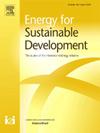Feasibility of shallow geothermal energy for industrial heating using high-temperature heat pumps in Sichuan Province, China
IF 4.9
2区 工程技术
Q2 ENERGY & FUELS
引用次数: 0
Abstract
Industrial energy consumption plays a pivotal role in the global energy landscape and offers considerable potential for carbon emission mitigation. The integration of shallow geothermal energy, which is widely distributed and easily accessible, with high-temperature heat pump technology presents a viable solution for industrial heating applications requiring temperatures below 100 C. This study investigates the feasibility of utilizing shallow geothermal energy and existing oil and gas wells for industrial process heating in major cities of Sichuan Province, China. Through a comprehensive analysis of low-temperature industrial heating demand, shallow geothermal energy potential, existing well resources, and project economic benefits, the study reveals that a substantial low-temperature industrial heating demand of approximately 116.3 million GJ (3.97 million tons of standard coal equivalent (tce)) in the study area. Sichuan Province possesses significant exploitable shallow geothermal energy resources, estimated at 410.3 million GJ (14 million tce), along with 10,000 oil and gas wells and thousands of abandoned wells, which collectively can satisfy this demand. Economic analysis indicates that the Levelized Cost of Heating (LCOH) for shallow geothermal projects is 0.057 USD/ (0.400 CNY/), while existing well projects demonstrate a lower LCOH of 0.039 USD/ (0.271 CNY/), both slightly higher than natural gas boiler costs. The economic assessment shows that shallow geothermal projects can achieve a maximum Net Present Value (NPV) of approximately 1.01 billion USD (7.08 billion CNY), whereas existing well projects can reach up to 11.92 billion USD (83.45 billion CNY). The Dynamic Payback Period (DPP) analysis reveals that all existing well projects achieve payback within 1 year, while shallow geothermal projects show payback periods ranging from 7 to 14 years. These results substantiate the technical and economic feasibility of implementing shallow geothermal energy and existing well systems for industrial process heating. This model demonstrates significant potential for replication in other urban areas, offering dual benefits of economic advantages for industrial operations and substantial contributions to achieving national carbon neutrality objectives.
四川高温热泵用于工业供暖的浅层地热能可行性研究
工业能源消费在全球能源格局中发挥着关键作用,为减少碳排放提供了相当大的潜力。将分布广泛且易于获取的浅层地热能与高温热泵技术相结合,为温度要求低于100°C的工业供热应用提供了可行的解决方案。本研究探讨了四川省主要城市利用浅层地热能和现有油气井进行工业过程供暖的可行性。通过对低温工业采暖需求、浅层地热能潜力、现有井资源和项目经济效益的综合分析,研究区低温工业采暖需求约为1.163亿GJ(397万吨标准煤当量)。四川省拥有重要的浅层地热可开发资源,估计有4.103亿GJ(1400万立方米),还有1万口油气井和数千口废弃井,可以满足这一需求。经济分析表明,浅层地热项目的平均供热成本(LCOH)为0.057美元/千瓦时(0.400元/千瓦时),而现有井项目的LCOH较低,为0.039美元/千瓦时(0.271元/千瓦时),均略高于天然气锅炉成本。经济评价表明,浅层地热项目最大净现值(NPV)约为10.1亿美元(70.8亿元人民币),而现有井项目可达119.2亿美元(834.5亿元人民币)。动态投资回收期(DPP)分析表明,所有现有的井项目都在1年内实现投资回收期,而浅层地热项目的投资回收期为7至14年。这些结果证实了实施浅层地热能和现有井系统用于工业过程加热的技术和经济可行性。这一模式显示出在其他城市地区复制的巨大潜力,为工业运营提供经济优势和为实现国家碳中和目标作出重大贡献的双重效益。
本文章由计算机程序翻译,如有差异,请以英文原文为准。
求助全文
约1分钟内获得全文
求助全文
来源期刊

Energy for Sustainable Development
ENERGY & FUELS-ENERGY & FUELS
CiteScore
8.10
自引率
9.10%
发文量
187
审稿时长
6-12 weeks
期刊介绍:
Published on behalf of the International Energy Initiative, Energy for Sustainable Development is the journal for decision makers, managers, consultants, policy makers, planners and researchers in both government and non-government organizations. It publishes original research and reviews about energy in developing countries, sustainable development, energy resources, technologies, policies and interactions.
 求助内容:
求助内容: 应助结果提醒方式:
应助结果提醒方式:


